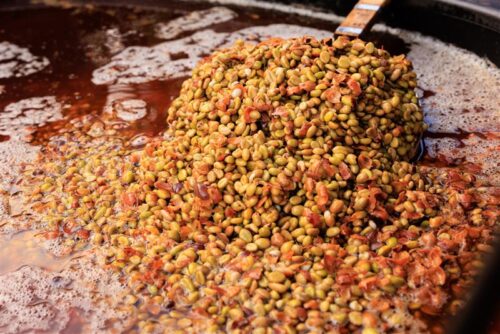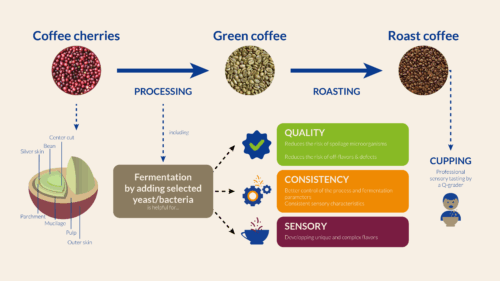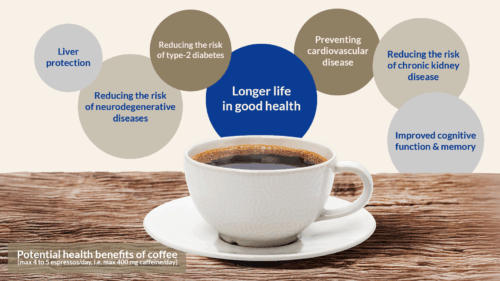What is coffee?
Basically, coffee is a beverage made from the roasted seeds of plants of the Coffea genus, principally Coffea arabica and Coffea canephora (commonly known as Robusta). But this definition is only the tip of the iceberg. Coffee is an agricultural product, but above all a product of fermentation.
Before being a beverage, coffee is a fruit. In fact, what we commonly call a “coffee bean” is actually the seed of a fruit, called a cherry, which grows in tropical regions. Arabica, a more delicate variety, grows at higher altitudes and often produces finer coffees. Robusta, more vigorous, grows in lowlands and produces a full-bodied coffee, richer in caffeine.
Once harvested at maturity, the coffee cherry undergoes a series of transformations – including fermentation – before being roasted, ground and finally infused. It is this succession of stages that shapes the flavours of the coffee we drink.
Who drinks the most coffee?
Did you know that coffee is the second most important commodity on the world market after crude oil?
With its stimulating and energizing effects, coffee is the most widely consumed beverage in the world after water. According to the International Coffee Organization, over 10 million tons of coffee are consumed worldwide every year, equivalent to nearly 3 billion cups of coffee a day(1)!
While Brazil remains the world’s biggest coffee producer, it’s the Nordic countries (Finland, Norway, Sweden, Denmark) that top the ranking in terms of per capita consumption, with Finland on the podium (around 10 kg/year), with a preference for lightly roasted coffee. The Chinese consume an average of 16 cups a year(2)compared with 3 cups/day for an American.
Arabica accounts for around 60% of the world’s coffee production, due to its higher chemical complexity. It is appreciated for its delicate, complex aromatic profile.
Where does coffee come from?
Coffee is thought to have originated in Ethiopia around the 9th century, where its beans were initially chewed for energy by local tribes. The use of coffee as a beverage spread to the Arabian Peninsula, and by the 16th century it was known in Persia, Egypt, Syria and Turkey. Historically, coffee was not only consumed for pleasure but also appreciated for its medicinal properties(3).
By the 17th century, coffee had reached Europe, and plantations were established in the colonies of Latin America, Asia and Africa. Today, the “coffee belt”, a region stretching on either side of the equator, produces most of the world’s coffee beans, with the main producers being Brazil, Vietnam, Indonesia, Colombia and Ethiopia.
What makes coffee so good?
We love coffee above all for its complex taste, a symphony of acidity, sweetness, bitterness and aromas. Over 1,000 volatile organic compounds (VOCs) have been identified, more than in wine. However, several studies have shown that only 5% of the VOCs identified actually contribute to coffee’s aroma(4).
VOCs in coffee depend not only on the species and geographical origin, but are also influenced by post-harvest processing, roasting, storage and extraction conditions.
Today, coffee-based beverages are seen as a real drinking experience, and consumers no longer hesitate to pay more for singular coffees. As a result, specialty coffees, defined as beverages of exceptional quality distinguished by their unique flavors and characteristics, have gained in popularity. One of the keys to developing exceptional coffees is to use selected microorganisms or starter cultures, as in the manufacture of many fermented products, such as wines, cheeses or certain panary sourdoughs.
How do you explain the taste and flavours of coffee?
Coffee quality is determined 40% in the field, 40% during primary post-harvest processing (fermentation & drying & storage) and 20% during secondary processing (roasting & grinding & infusion(5). This underlines the importance of fermentation in improving coffee quality and value.
Once the coffee cherries have been harvested and sorted, they need to be processed to remove the pulp and mucilage surrounding the seed. This is where fermentation and microorganisms come into play.
Fermentation is a natural biochemical process carried out by micro-organisms, during which carbohydrates or other organic compounds are consumed and transformed into acids, alcohol and other metabolites, while energy is released.
There are 3 conventional ways to ferment coffee.
The choice of method is considered to be one of the most differentiating stages in its quality:

- The dry or “natural” method, used in regions where access to water is difficult: the process involves transferring the whole fruit (with the mucilage) to a drying platform, where it is fermented and dried. The dried cherries are then shelled. The result is green coffee.
- The wet method or washed processing: after mechanically removing the skin and pulp from the fruit, the mucilage-covered cherries are immersed in hermetically sealed fermentation tanks for between 12h and 100h.
The fermented beans are then washed, dried and shelled (to remove the parchment).
Note that there are 3 variations:- the semi-washed method, with a short immersion time
- the double-wash method with two successive immersions.
- The wet-hulled (ou Giling Basah) method: after immersion, the coffee is dried a first time. When it reaches 30% humidity, the parchment (shell protecting the seed) is removed and the coffee is then dried again.
- The semi-dry “honey” method: this hybrid coffee processing technique lies somewhere between the wet and dry methods. After pulping the cherries, the coffee beans are dried with all or part of the mucilage still intact.
Two other fermentation methods are more exceptional:
- The carbonic maceration method: this new experimental technique involves leaving intact coffee beans sealed in a closed environment filled with CO2, where oxygen has been expelled. The aim is to encourage microbial fermentation inside the fruit(6).
- The digestion method: in this process, the cherries are digested by the enzymes and microorganisms present in the digestive systems of animals such as the Asian civet cat (Luwak). The coffee beans are harvested from the animals’ excrement. Developed mainly in Indonesia, Kopi Iuwak coffee is one of the world’s most expensive coffees (around €70 a cup).
Each method favors the development of a distinct microbial community, especially yeasts and bacteria, whose metabolism contributes to the organoleptic construction of the coffee. Studies have shown that microbial metabolites produced during fermentation will migrate into the coffee beans to modulate the flavor, aroma and sensory quality of the final product.
Wet processing generates more exceptional sensory characteristics than dry processing. Indeed, anaerobic fermentations (oxygen restriction) are conducive to a high prevalence of fermentative microorganisms, notably yeasts and lactic acid bacteria.
Roasting then transforms the aroma precursors through Maillard and caramelization reactions, generating new aromatic and taste compounds.
Coffee is a fermented product
Like sourdough, chocolate or kombucha, coffee depends on microbial action to develop its complexity. Studies using metagenomics and metabolomics have revealed the diversity of endogenous species involved in the fermentation process(7):
- Yeasts such as Saccharomyces cerevisiae, Pichia, Candida and Hanseniaspora. In Brazil, over 140 yeasts have been identified in the wet processing method.
The metabolic activities of yeast produce secondary metabolites, such as alcohols, acids, esters and aldehydes, which migrate into the coffee bean and act as flavor precursors during roasting. In addition, yeast enzymes help degrade the mucilage and suppress any mycotoxin-producing fungi.
- Lactic acid bacteria (LAB) such as Lactobacillus, Leuconostoc, Erwinia, Pseudomonas , Klebsiella and Enterobacter produce organic acids during lactic acid fermentation, reinforcing the perceived acidity and generating secondary metabolites.
Yeast and bacteria work in synergy to break down the sugar-rich mucilage.
- Filamentous fungi: Aspergillus and Fusarium are generally the most widespread filamentous fungi in the primary coffee process.
Filamentous fungi predominate at the end of processing and during storage, and can affect the quality and safety of the final product through the production of mycotoxins. Microbial contamination can occur in cherries and during harvesting, fermentation, drying and storage of coffee beans.
Traditionally, coffee cherry fermentation was a natural process, shaped by the microorganisms in the environment. However, innovative producers are experimenting with starter cultures, using selected strains of yeast that open up a field of possibilities for creating unique and extraordinary coffee aromas.

With this in mind, and with the collaboration of the Nicafrance Foundation, which conducts innovative projects in its laboratories located in the heart of Nicaragua’s coffee-growing zone, researchers at Lesaffre and its Fermentis by Lesaffre Business Unit have selected particularly robust Saccharomyces yeast strains from the Group’s collection. From this research program emerged the SafCoffee™ range of active dry yeasts, which delivers distinctive and consistently complex high-end flavor notes (notes of tropical fruit, caramel and chocolate, vanilla and peanuts or chocolate mixed with fruity, spicy and floral aromas).
It is recognized that coffee beans fermented with yeast have higher sensory scores in terms of aroma, flavor, acidity, body and overall tasting score(8).
The use of starter culture technology also helps to normalize the duration of the fermentation process and reduce the risk of unpleasant flavors caused by undesirable micro-organisms.
In terms of research, Brazil is the main contributor to coffee bean fermentation, focusing on the design of controlled fermentations and the evaluation of the influence of microorganisms and processing conditions on the sensory quality and composition of coffee(() (9) ()).
Given the superior positioning of specialty coffees, many producers today choose to use selected yeasts to improve quality and obtain coffees with unique characteristics.
Is coffee good for you? The benefits of coffee

It’s not just the taste that counts. Although coffee drinking is not yet considered a health behavior, a great deal of research suggests that coffee is good for our bodies when consumed in moderation.
An important source of bioactive compounds such as caffeine, trigonelline, chlorogenic acids, tryptophan alkaloids and diterpenes, coffee is associated with a range of health benefits:
- Liver protection, in particular against non-alcoholic fatty liver disease (NAFLD). Coffee consumption may be associated with a reduced risk of NAFLD according to a dose-response relationship(10).
- Potential prevention of cardiovascular disease (CVD): the European Society of Cardiology points out that coffee consumption of 3 to 4 cups a day could be moderately beneficial in preventing CVD(11).
- Reduced risk of type 2 diabetes: coffee consumption is inversely associated with the risk of developing type 2 diabetes according to a dose-response relationship, with the greatest risk reduction observed for high consumption (≥ 6 cups/day).
- Reduced risk of chronic kidney disease (CKD): coffee consumption is associated with a reduced risk of CKD in a dose-dependent manner; higher doses are associated with greater risk reductions.
- Lower mortality risk: coffee consumption is generally associated with a lower risk of all-cause mortality, in line with a non-linear U-shape, with the greatest risk reduction observed for moderate consumption (1 to 5 cups/day).
- Improved healthy lifespan* and increased longevity: Coffee consumption could promote longevity and health through its effects on fundamental biological processes involved in aging. These include attenuating oxidative stress and inflammation, improving mitochondrial function, repairing DNA, stimulating autophagy, modulating epigenetic regulation and regulating cellular metabolic pathways. Each of these mechanisms plays an essential role in slowing down the aging process and reducing the incidence of age-related diseases. Presented at Nutrition 2025, the flagship annual meeting of the American Society for Nutrition, a study conducted by Harvard TH Chan School of Public Health scientists on 47,513 women aged 45 to 60 and followed for 30 years suggests that caffeinated coffee – not tea or decaffeinated – may “uniquely promote aging trajectories that preserve mental and physical function in women”(12). Thus, women who consumed moderate amounts of caffeinated coffee in their forties were more likely to age in good health, provided of course that they had a healthy lifestyle.
- Improved cognitive functions and memory: moderate coffee consumption can improve various aspects of cognitive performance, including attention, vigilance, processing speed and certain executive functions. However, the cognitive effects of coffee are influenced by several moderating factors, such as dose, individual differences…(13)
- Reduced risk of neurodegenerative diseases: increased consumption of unsweetened coffee may be associated with a reduced risk of neurodegenerative diseases (e.g. Alzheimer’s and Parkinson’s disease), thanks in particular to caffeine’s neuroprotective effects, such as reduced production of β-amyloid peptide (Aβ) and oxidative stress(14).
Naturally present in coffee, caffeine is a purine alkaloid and a powerful psychostimulant, which acts by blocking adenosine receptors in the brain, preventing drowsiness and promoting alertness.
Furthermore, the caffeine contained in coffee has been shown to improve energy metabolism and increase caloric expenditure, which may delay the onset of the metabolic decline associated with aging.
The concentration of caffeine in coffees can vary considerably. In one study, the amount of caffeine in 14 brewed specialty coffees ranged from 72 to 130 mg. Note that a filter coffee (around 20 cl) contains more caffeine than an espresso (3 to 5 cl).
However despite its potential benefits, coffee consumption can lead to undesirable effects such as anxiety, sleep disorders, cardiovascular problems and addiction. Excessive consumption or individual sensitivity to caffeine can trigger the secretion of stress hormones such as cortisol and epinephrine, contributing to physiological arousal and anxiety symptoms.
Is specialty coffee the best coffee ever?
While mass-produced coffee still dominates the market, there is a noticeable trend towards specialty coffee, a movement that values quality, traceability and sustainability. These coffees are often accompanied by detailed information on variety, plantation, processing method and roasting profile. In some regions, such as North America, consumption of specialty coffees now exceeds traditional consumption.
Today’s consumers are prepared to pay a premium for unique flavours, ethical sourcing and the artistry of skilled baristas. This trend has transformed coffee into a terroir product, like wine, where factors such as soil, altitude and fermentation contribute to the complexity of its flavor.
Today, specialty coffee plays a key role in the popularity of coffee, stimulating innovation, notably with more personalized coffee experiences (choice of origin, brewing method, type of milk, hot or iced…).
Coffee is also a generational issue: millennials appreciate the convenience of instant coffee and even the can with its dose of caffeine, while older generations still tend to prefer the coffee machine.
Does the way coffee is prepared affect its taste? Coffee as a ritual
Beyond biochemistry and sensory analysis, coffee is deeply emotional and cultural. It’s a ritual, a shared experience, a solitary moment, a break in the day. Whether it’s a quick espresso in an Italian café, a Japanese ceremony involving the art of making coffee without a machine, or a strong Turkish coffee, coffee rituals reflect identity and belonging to a community.
Of course, everyone has their own preference, between filter coffee, espresso, café noisette, cappuccino… more than 25 different variants. However, in the USA and Canada, 61% of consumers prefer filter coffee, compared with 43% in France. Hot or cold brew? Cold-brewed coffees tend to have a less bitter, sweeter taste profile than their hot-brewed counterparts, and are therefore increasingly accepted by consumers(14).
Whatever the preparation method, for a good coffee, temperature, extraction time, brewing pressure, brewing ratio, degree of grinding and water quality are all factors likely to modify its aromatic profile, and therefore its quality(15). Preparing coffee is an art that deserves our full attention if we are to enjoy the full expression of its flavours.
Which is the best coffee?
The best coffee is not a single origin or roasting level. It’s the one that speaks to your palate, matches your ritual and perhaps even connects you to the invisible world of microbes that have transformed a fruit seed into an elixir.
Behind every cup is a complex dance of biology, chemistry and know-how, at the heart of which are tiny organisms doing extraordinary things.
The next time you enjoy your coffee, remember that you’re not just tasting beans and heat, but also fermentation, tradition and life itself.
* Healthy aging has been defined as living to age 70 or older, being free of 11 major chronic diseases, maintaining physical function, having good mental health, no cognitive impairment and no memory complaints.
Sources :
- Coffee Development Report, “Beyond Coffee: Towards a Circular Coffee Economy 2022-23”.
- https://daoinsights.com/news/shanghai-takes-the-lead-as-chinese-coffee-consumption-averages-16-cups-per-year/
- Ungvari, Z., Kunutsor, S.K. Coffee consumption and cardiometabolic health: a comprehensive review of the evidence. GeroScience 46, 6473-6510 (2024). https://doi.org/10.1007/s11357-024-01262-5
- Obando, A.M.; Figueroa, J.G. Effect of Roasting Level on the Development of Key Aroma-Active Compounds in Coffee. Molecules 2024, 29, 4723. https://doi.org/10.3390/molecules29194723
- Bealu Girma, Abrar Sualeh. A Review of Coffee Processing Methods and Their Influence on Aroma. International Journal of Food Engineering and Technology. Vol. 6, No. 1, 2022, pp. 7-16. doi: 10.11648/j.ijfet.20220601.12
- Xiaotong Cao, Hanjing Wu, Claudia G Viejo, Frank R Dunshea, Hafiz A R Suleria, Effects of postharvest processing on aroma formation in roasted coffee – a review, International Journal of Food Science and Technology, Volume 58, Issue 3, March 2023, Pages 1007-1027, https://doi.org/10.1111/ijfs.16261
- Hosam Elhalis, Julian Cox, Jian Zhao, Coffee fermentation: Expedition from traditional to controlled process and perspectives for industrialization, Applied Food Research, Volume 3, Issue 1, 2023, 100253 https://doi.org/10.1016/j.afres.2022.100253. (https://www.sciencedirect.com/science/article/pii/S2772502222002086)
- Shen, X.; Wang, Q.; Wang, H.; Fang, G.; Li, Y.; Zhang, J.; Liu, K. Microbial Characteristics and Functions in Coffee Fermentation: A Review. Fermentation 2025, 11, 5.https://doi.org/10.3390/fermentation11010005
- https://www.innovamarketinsights.com/trends/coffee-trends-in-the-us/
- Ungvari, Z., Kunutsor, S.K. Coffee consumption and cardiometabolic health: a comprehensive review of the evidence. GeroScience 46, 6473-6510 (2024). https://doi.org/10.1007/s11357-024-01262-5
- Visseren FLJ, Mach F, Smulders YM, Carballo D, Koskinas KC, Back M, et al. 2021 ESC Guidelines on cardiovascular disease prevention in clinical practice. European Heart Journal, Volume 42, Issue 34, 7 September 2021, Pages 3227-3337, https://doi.org/10.1093/eurheartj/ehab484
- https://www.sci.news/
- Payman Raise-Abdullahi, Ehsan Raeis-Abdollahi, Morvarid Meamar, Ali Rashidy-Pour, Chapter Seven – Effects of coffee on cognitive function,- Progress in Brain Research, Elsevier, Volume 288, 2024, Pages 133-166, https://doi.org/10.1016/bs.pbr.2024.06.016. (https://www.sciencedirect.com/science/article/pii/S0079612324001122)
- Tingjing Zhang, Jiangen Song, Zhenfei Shen, Kewan Yin, Feifei Yang, Honghao Yang, Zheng Ma, Liangkai Chen, Yanhui Lu, Yang Xia, Associations between different coffee types, neurodegenerative diseases, and related mortality: findings from a large prospective cohort study, The American Journal of Clinical Nutrition, Volume 120, Issue 4, 2024, Pages 918-926.https://doi.org/10.1016/j.ajcnut.2024.08.012. (https://www.sciencedirect.com/science/article/pii/S0002916524006713)
- Xiuju Wang, Loong-Tak Lim, Effects of grind size, temperature, and brewing ratio on immersion cold brewed and French press hot brewed coffees, Applied Food Research, Volume 3, Issue 2, 2023, 100334,https://doi.org/10.1016/j.afres.2023.100334. (https://www.sciencedirect.com/science/article/pii/S2772502223000719)


